Automatic gun S.N. McClin. American gun for the Russian army
The automatic gun caliber 37 mm was developed in the early years of the XX century. The author of the project was the American gunsmith designer Samuel Neal McClin, who headed his own company McClean Ordnance and Arms Co. From the end of the XIX century S.N. McClin studied the subject of automatic weapons, including artillery. Soon, theoretical studies led to the first real results. In 1902, the inventor proposed and soon patented the design of an automatic gun caliber 37 mm. In some sources, this development is referred to as McClean Mk I, which allows to distinguish it from newer versions of the gun.
Already in the first project S.N. McClin formulated the main features of the design of advanced weapons, which later on without significant changes were used in newer projects. During the tests and fine-tuning of the gun, certain changes were made to the design of individual components and assemblies, but the overall appearance of the weapon remained unchanged until the very end of the design work and mass production.
In the first version, the McClin gun was an automatic gun with gas automatics, using an 37-mm unitary shot with a black powder propelling charge. The ammunition system used detachable box magazines or clips on 5 or 10 shells. Initially, the gun was proposed to mount on the machine with a wheel course, but its design did not interfere with the use of other artillery installations. In particular, at one of the stages of the test, a thumbnail unit and means were used to mount the instrument in the body of a serial truck.
The McClean Mk I gun had a rifled barrel with a 37 caliber mm and a 1887 mm length (51 caliber). It was proposed to use the standard "one-pound" shot, which was in service with the US Army. The existing long barrel allowed the projectile to be accelerated up to a speed of about 2100 feet per second (640 m / s), which made it possible to obtain sufficiently high combat qualities. Due to the automatics with a gas engine, the gun could shoot in bursts, but there is no exact information about the rate of fire of the first version of the gun.
The McClean Mk I project appeared in 1902. The following year, the company S.N. McClyn built a prototype gun and handed it over to the US Army for testing. In 1903 and 1904, artillery specialists and design company representatives jointly conducted various tests at the Sandy Hook test site. Field inspections showed that the proposed design of a promising weapon really allows you to fire in automatic mode and literally cover the enemy with a hail of shells. However, the actual combat qualities of the Mk I system were not established. During tests, delays in shooting regularly and various minor instrument failures occurred. As it was found out, the destruction of individual parts of the gun was associated with a violation of their manufacturing technology. Improper heat treatment reduced the strength of the aggregates, and they simply could not cope with the loads when fired.
At this stage, Poole Engeneering Co., which had experience with precise mechanisms and had certain technologies, was involved in the project. S.N. McClin, together with the engineers of this organization, began work on improving the existing project. Measures were taken regarding the strength of the main parts. In addition, the system of projectile delivery and the firing mechanism was subjected to noticeable alterations. An enlarged barrel with a length of 54 caliber was also used. Other components and assemblies, in general, remained the same. As a result, the technical characteristics of the gun should not have changed, although the expected increase in reliability. In updated form, the gun was called McClean Mk II.
The upgraded gun went to the landfill in 1905 year. According to the available data, its tests revealed a real increase in reliability with a decrease in the risk of destruction of individual parts. However, the basic mechanisms of automation still refused to work properly. Most of the shots at this stage of the test had to be done using “traditional” manual reloading. The technical characteristics of the gas engine and the fighting qualities associated with it were not established again.
Despite another setback, the project was not closed. S.N. McClin continued the work, but with the help of a new subcontractor. Another participant of the project is Driggs Ordnance Co. McClin and Driggs continued to work together over the next few years. During the second half of the zero years of the 20th century, two organizations were engaged in designing an improved version of the gun, collecting prototypes and conducting their tests, which resulted in new adjustments being made to the project.
During these tests, curious experiments were conducted. Thus, one of the guns McClean Mk II mounted on a stand installation in the back of a Packard truck. With the help of such an improvised combat vehicle, it was possible to establish the prospects for self-propelled artillery. One of the guns was sent to the UK, where the staff of Driggs-Schroeder Co. installed it on the car brand Maudsley. This experiment allowed us to collect new information on the joint use of automotive vehicles and small-caliber guns.
Improvements to the project and various tests of the McClean Mk II gun continued until the 1909 year. After that, S.N. McClin decided to suspend work due to the apparent lack of commercial prospects. It took seven years to refine the project and achieve the required characteristics of automatic guns, but even after that no potential customer wanted to acquire such weapons. Further work on the project was considered inexpedient. The project 37-mm guns was minimized, and the designers engaged in the development of other types of small arms and artillery weapons.
The return of McClin's guns to the market took place in 1916. By this time, the Russian Empire, participating in the First World War, had time to face a host of industrial problems, because of which it showed a special interest in weapons and equipment of foreign production. One of the results of this interest was the signing of a contract with McClean Ordnance and Arms Co. and Driggs Ordnance Co. In accordance with the agreement, American enterprises had to manufacture three hundred automatic cannons and transfer them to the Russian army. The contract also determined some features of the weapons being purchased, a delivery set, etc. On some of the remaining weapons there are information signs, according to which a part of the ordered products was produced by Poole Engeneering Co. under a license agreement.
The guns ordered by Russia are called McClean Mk III. Before deploying mass production, the existing project was noticeably refined, and it was decided to consider the result of this work as a full-fledged modification of the instrument. The updated project offered some changes directly related to the wishes of the customer. In addition, when another design was refined, the results of previous tests were taken into account. Thus, the most perfect modification of the gun, which had a completely formed appearance, went into the series. Even if a decade and a half after the start of work, but the project was completed and brought to mass production.
McClin’s Mk III gun was distinguished by its relatively simple design and original layout. There was a long barrel, under which there was a gas chamber and a piston that actuated the automation. The breech trunk and the back of the piston were part of a receiver of complex shape, which had a characteristic cross-section in the form of eight. On the right surface of the receiver there was a receiving shaft store, on the left - a device for the withdrawal of spent cartridges. An interesting feature of the gun was the presence of the butt and pistol grip with a trigger.
In the final version of the project, the gun received an 37-mm rifled barrel with a length of 50 calibers. In the muzzle of the barrel there was a conical expansion, which was the original muzzle brake. Inside the expanding part of the trunk there were several annular cavities separated by inclined partitions. When fired, the powder gases had to enter these cavities and push the barrel forward, compensating part of the recoil impulse. Behind the muzzle brake was a unit for connecting with the gas chamber. It was proposed to direct the gases to the gas engine by means of several gas vents located along the axis of the barrel.
A device for removal of gases from the barrel, which also served as a strength element of the structure, was made in the form of a part consisting of two connected tubes. The top was placed on the barrel, and the tubular piston casing was attached to the back of the bottom. In the front wall of the gas chamber there was a valve for adjusting the pressure in the internal volume. Through the rear window, a spring-loaded piston entered it. The latter was partially inside the protective tube-casing. Its rear part was placed openly, after which it entered the corresponding hole of the receiver.
The receiver was a single piece with a cross section in the form of "8". Inside it there were two cylindrical cavities interconnected. The top one was intended for the installation of the shutter, and the elements of the gas engine had to move at the bottom. Receiver received a back cover, which could be removed for maintenance weapons. On the side and bottom surfaces of the box there were some additional units and protrusions of one purpose or another.
S.N. McClin proposed the original design of automation. In the upper cavity of the receiver had to move a cylindrical gate, inside which there was a movable drummer. Mechanisms for locking the barrel were not provided. The lower cavity contained a movable cylindrical block, necessary for the correct movement of the gate and its drummer. This unit is directly in contact with the gas engine piston. He also had to interact with the sear.
The McClean Mk III gun had an original firing-type trigger mechanism, the details of which were spaced apart in different parts of the receiver. Fire control was carried out using the trigger placed on the pistol grip. The hook was in the form of a long, double-shouldered lever, the front of which interacted with the sear which was directly responsible for locking or lowering the shutter. Inside the shutter and the lower movable unit was placed drummer of unusual shape. The upper part had a needle head to ignite the primer, and the lower part was made in the form of an obliquely located protrusion entering the groove of the moving unit.
The USM also had an original fuse-translator of fire. On the left surface of the pistol grip was located a movable lever associated with the disc. The latter had a set of special grooves interacting with the trigger. At different positions of the lever, different grooves had to be in contact with the hook, which made it possible to block it, to allow fire with single or firing bursts.
The McClin gun was supposed to use a single-pound unitary projectile (37x137 mm R). The shells were placed in the holder on 5 or 10 shots, which, in turn, was installed in the receiving shaft of the gun. Mine was located on the right side of the receiver and had the characteristic shape of the upper cut. The shells were to fall inside the mine under its own weight. The projectile was sent to the dosing line using a spring-loaded pusher swinging on an axis parallel to the barrel. When the bolt departed to the rear position, the pusher swung and sent the lower projectile from the cage inside the upper cavity, at the same time not allowing the next ammunition to drop. When moving the bolt forward, the pusher went to its original position, after which the new projectile fell down.
The gun received an open mechanical sight, similar to that used in the composition of small arms and allowing direct fire. The sight was placed on the receiver. In the muzzle of the trunk was unregulated fly.
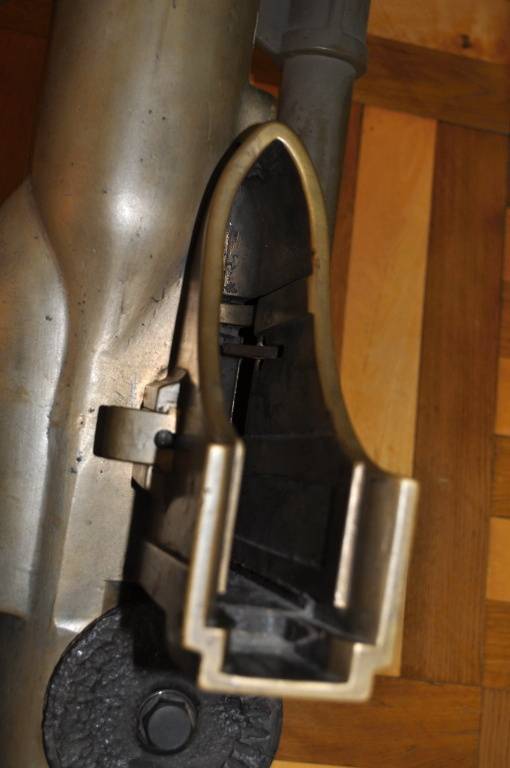
Reception shaft cage. Photo Forum.valka.cz
The Russian army ordered a McClin gun with two versions of the machine. The first was a carriage with a wheel course. In its composition there were several pipes, combined in a rigid structure with a double rear frame. On the last one there was a coulter and a seat for the gunner. The carriage had simple screw guidance systems, which allowed shelling targets within the horizontal sector 9 ° wide at elevation from -5 ° to + 15 °. The line of fire was located at a height of 762 mm, provided with wheels with a diameter of about 1 m. The calculation of the gun was defended from enemy fire by a curved armor plate.
There was also a ship bollard. The basis of this device was a conical metal part with a set of windows for weight reduction. Such a support was to be mounted on a swivel base. In its upper part there was a U-shaped mount for the gun and a beam for installation of the mechanism of vertical pickup. Tumbovaya installation allowed to fire in any direction.
The body of the gun McClean Mk III had a length of more than 2 m and weighed 82 kg. When using the wheel carriage, the total mass of the entire artillery system increased to 304 kg without ammunition. The gun showed technical rate of fire at the level of 50-100 shots per minute and sent a projectile to the target at a speed of 650 m / s. The sighting range for the "Russian" guns was set at 3 versts (3,2 km). The maximum range is 5 versts (more than 5,3 km).
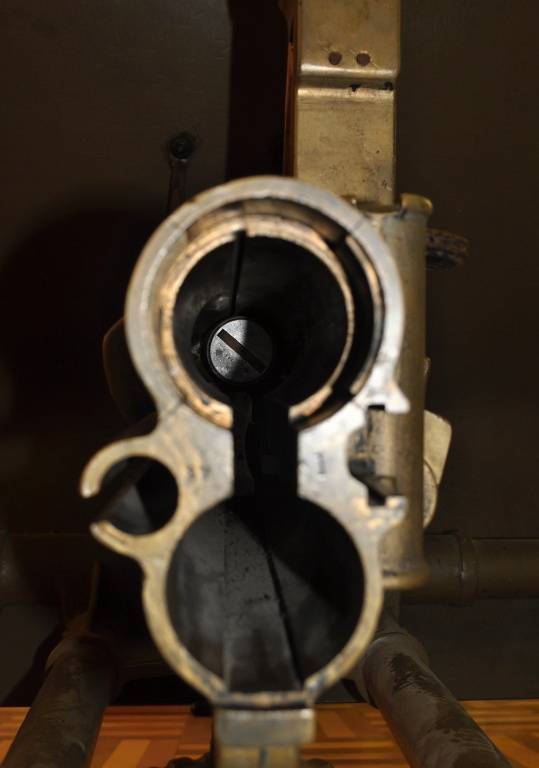
The back of the receiver, the cover is lost. Photo Forum.valka.cz
In order to carry out the shooting, the calculation of the gun had to place a clip with shells into the receiving shaft, and then cocking the mechanisms. When cocking the automation, the bolt and movable block of the lower cavity went back, where the latter was engaged with the sear. The retraction of the bolt allowed the pusher to send the lower shell into the upper cavity of the box. Then the gunner could turn off the fuse and select the desired shooting mode.
Pressing the trigger caused the sear to shift and unlock the lower moving unit. Under the action of the gas piston return spring, he had to go forward, dragging the bolt and drummer behind him. Leaving in the extreme front position, the bolt sent the projectile into the barrel and pressed against it. The mobile unit, in turn, continued to move and pulled the drummer behind him, which is why the shot occurred.
Powder gases when fired through a set of holes were supposed to fall into the gas chamber and put pressure on the piston. Under pressure, he went back, compressing the return spring. The moving piston pushed the movable block, which caused the shutter to move backwards. The bolt removed the sleeve and threw it through the pipe in the right wall of the receiver, and also worked on the side pusher, forcing him to send a new projectile into the weapon. Depending on the mode of fire, the moving parts of the automation were either blocked in the rear position, or they went ahead and made a new shot.
The order of the Russian army meant the assembly and supply of three hundred cannons. However, prior to the well-known 1917 events, the contracting companies were able to manufacture only 268 guns. Of these, 218 was able to transfer to the customer, while the rest did not leave the United States. Together with the guns supplied the necessary shells. In addition, each gun was attached to a hundred clips for shells. The weapons received by Russia were put into operation and were limitedly used on the fronts of the First World War.
The revolutionary events of 1917, led to a halt in the supply of new batches of guns. In the warehouses of manufacturers turned out about fifty weapons with an uncertain future. These guns were offered to the US Navy. In the middle of 1918, the US Navy, fearing the further development of German military equipment, took several guns of the McClean Mk III to conduct tests. However, the fighting soon ended, which allowed the US Navy to do without the urgent purchase of 37-mm automatic guns. Guns returned to storage.
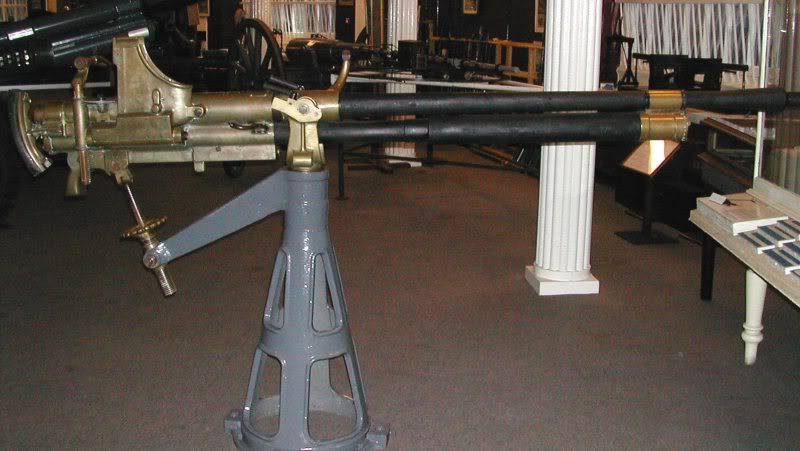
Museum sample gun McClean Mk III on the stand installation. Photo Network54.com
Of the three hundred cannons ordered, our country received only 218. Despite the small number, these weapons managed to take part in several wars on the side of different armies and armed formations. After the start of the Civil War, McClin’s guns went to both sides of the conflict. At the same time, they were used both by Russian units and by foreign formations: a number of such weapons were in service with the Czechoslovak Corps. Also, under certain circumstances, several guns ended up in Finland. As the fighting continued, the guns were repeatedly destroyed by artillery fire or became enemy trophies. As a result, individual guns had to not only go through a large combat path, but also repeatedly change owners.
According to reports, at the end of the tenths of the last century S.N. McClin made the last attempt to upgrade his gun. Such a project is mentioned in some sources under the name McClean Mk IV. It is known that such a gun was slightly modified, and increased performance should be achieved through the use of a new projectile. The 37-mm unitary shot was now equipped with a smokeless powder propelling charge. This made it possible to bring the initial velocity of the projectile to 730 m / s and to increase the other characteristics of the fire accordingly. Several new projectiles were also developed: high-explosive fragmentation, armor-piercing and armor-piercing fragmentation.
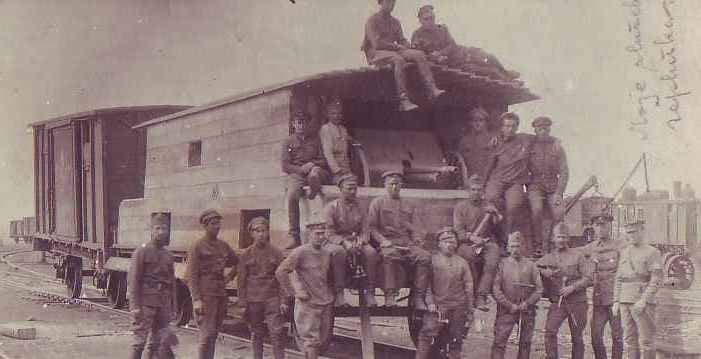
The soldiers of the Czechoslovak Corps and their guns installed in the car. Photo Forum.valka.cz
The development of the automatic cannon project continued until the 1919 year. Due to the lack of new orders and the presence of fifty guns left without a buyer, S.N. Mcklin and the management of enterprises engaged in the project, decided to abandon further work. Despite the possibility of firing bursts and fairly high combat characteristics, the original guns of the McClean family could not compete with other weapons of existing and future models. The project has been closed. The subsequent fate of the 50 guns, manufactured for Russia, but never transferred to the customer, is unknown.
After the end of the Civil War in Soviet Russia, a significant number of McClin’s guns still remained, suitable for further exploitation. By the mid-twenties, it was proposed to use a field gun as an anti-aircraft gun. Designer V.G. Fedorov created a special wheeled carriage, originally intended for firing a cannon at air targets. It was proposed to install a set of coulters-outriggers and a supporting conical bollard on a regular carriage with a wheel course. Due to this refinement, the gunner could freely direct the weapon in any direction along the azimuth, as well as raise it to large elevation angles.
This version of the automatic cannon was of some interest to the Red Army, but did not progress further experiments. The gun had insufficient characteristics for the control of airplanes, and the capabilities of the industry still did not allow for the mass production of such a weapon. As a result, the guns McClean Mk III remained field artillery weapons.
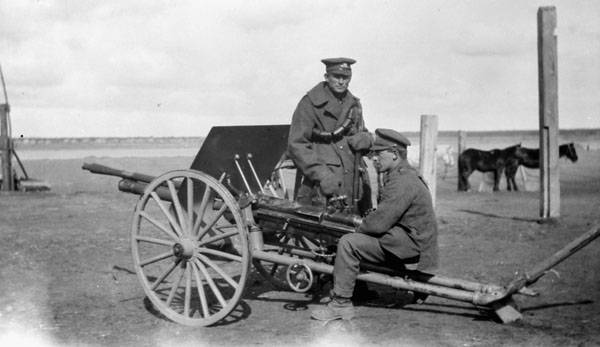
Canadian invaders examine captured cannon, May 1919. Photo by Wikimedia Commons
Over time, the armament of the Soviet Union received new models of artillery systems with higher characteristics, which allowed the outdated McClin guns to be decommissioned. However, the "career" of guns did not end there. In the mid-thirties, the Red Army specialists departed the stored guns and sent them to Spain as part of military assistance to the Republicans. According to various sources, the Spanish troops received at least three dozen guns. Such weapons performed well in urban battles, including with light armored vehicles of the enemy.
By the beginning of the Soviet-Finnish war, the army of Finland had four McClin guns, which were immediately sent to the front. Fortunately for the Red Army, for several decades the guns had become hopelessly outdated and no longer posed a serious threat to them. Moreover, only four guns by definition could not have a noticeable effect on the course of the fighting.
In some sources it is mentioned that up to fifty guns were taken out by the Czechoslovak Corps and for a certain time remained the army’s regular weapons. In the future, they were abandoned, sent for storage. In the thirties, the guns remaining in Czechoslovakia became trophies of the German army, but were not used by it. Only a few guns survived the war, one of which is still a museum exhibit. However, unfortunately for historians of weapons, this product has lost some of its details and is unlikely to ever be restored to its original form.
Samuel Neal McClin’s automatic cannon differed from other models of its time not only in design and capabilities, but also in unusual history. At first, for one and a half decades, the gun could not interest potential customers, but the appearance of a supply contract did not change the situation. Only three hundred guns were ordered, of which only 218 had time to transfer to the buyer. The well-known events of the 1917 of the year and the subsequent Civil War led to the fact that the list of operators of the McClean Mk III guns was replenished with new armies and armed formations. Finally, several dozen of these guns were able to make war in Spain and Finland. However, in all these cases, the list of armies using automatic guns was replenished with the same guns, but not with new orders.
Due to the small production volumes, only a few McClin’s cannons have survived in various versions, on a wheeled carriage and a stand installation. All of these samples are now museum pieces and are stored in different countries. Thanks to this, everyone who wants can have the personal acquaintance with the unique representatives of their era.
Based on:
http://iwm.org.uk/
http://forum.valka.cz/
http://network54.com/
http://strangernn.livejournal.com/
https://google.ru/patents/US933098
https://google.ru/patents/US785974
https://google.ru/patents/US1003632
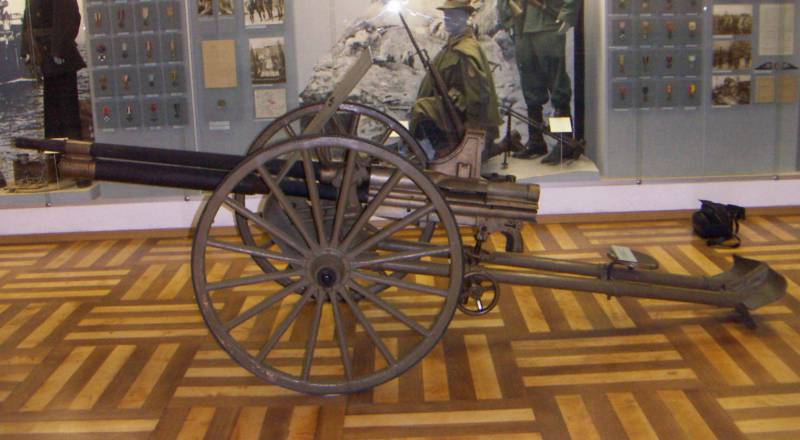
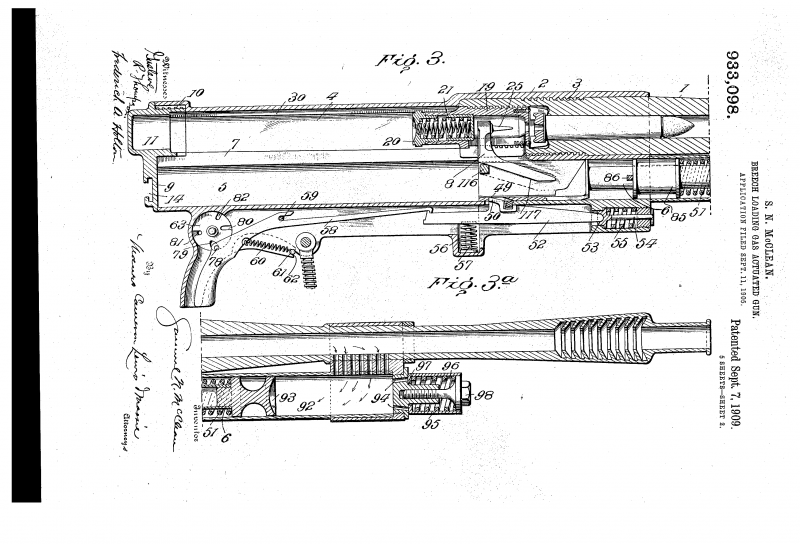
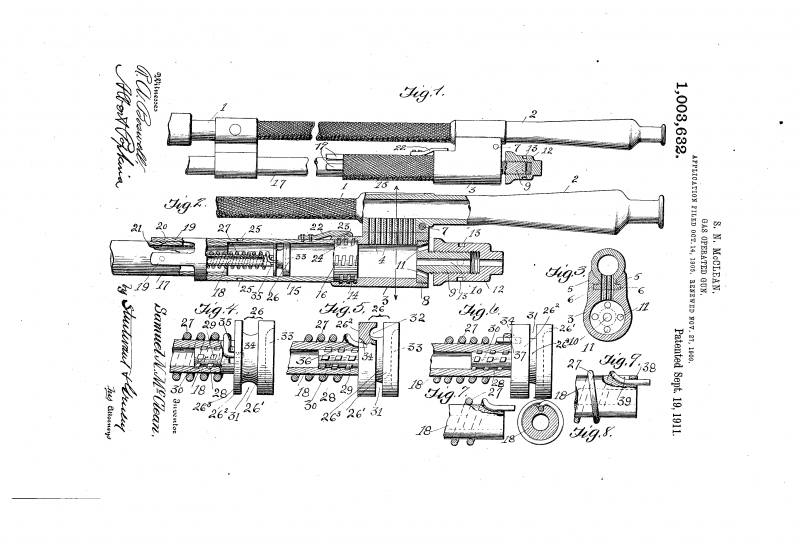
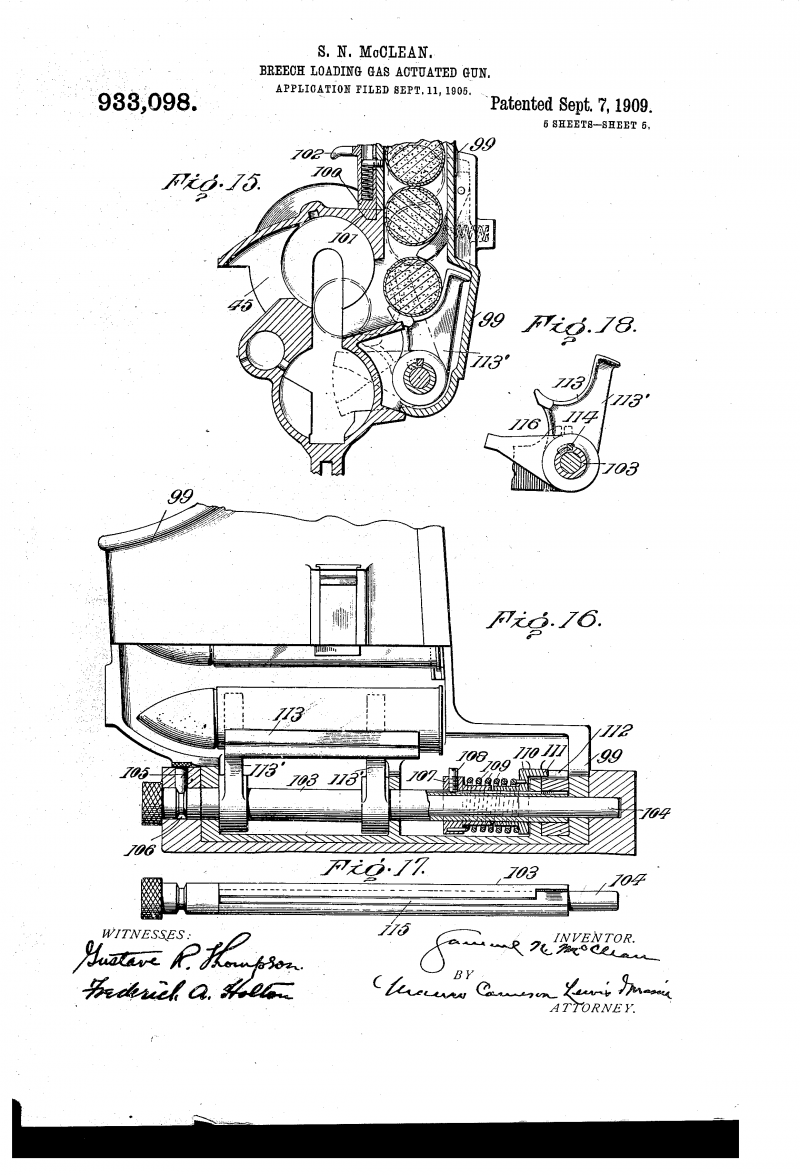
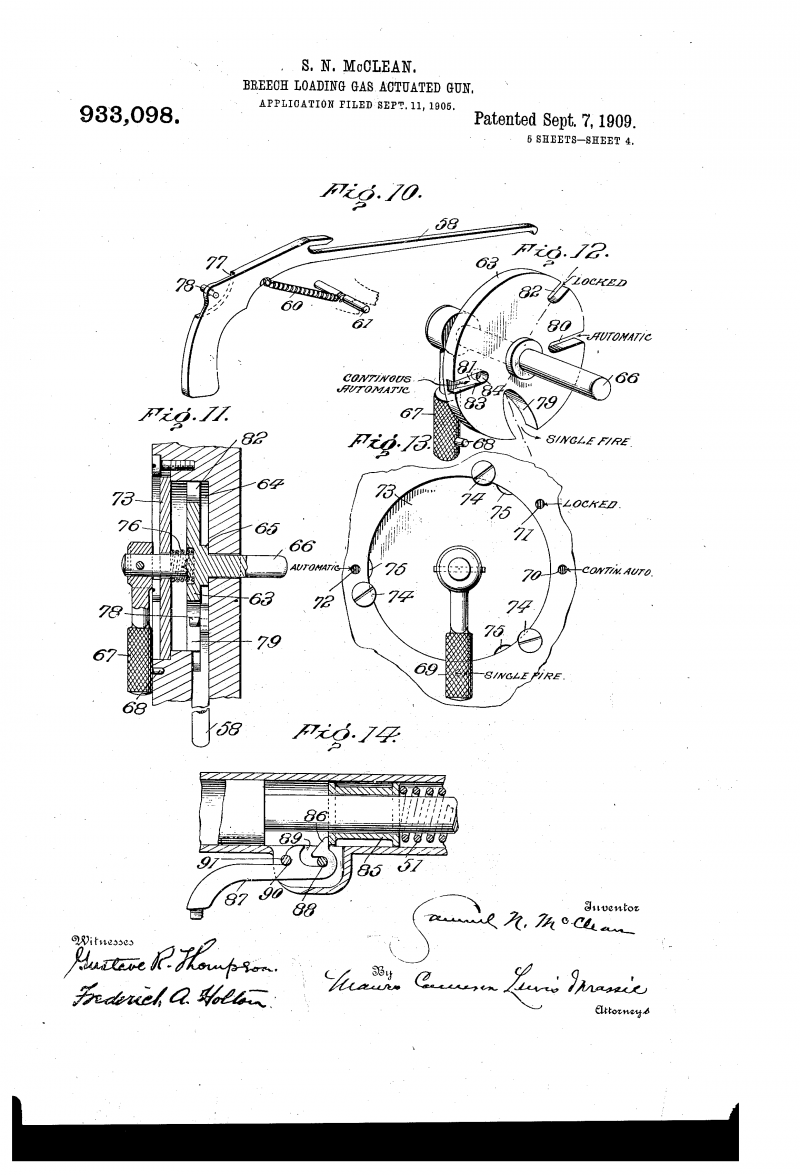
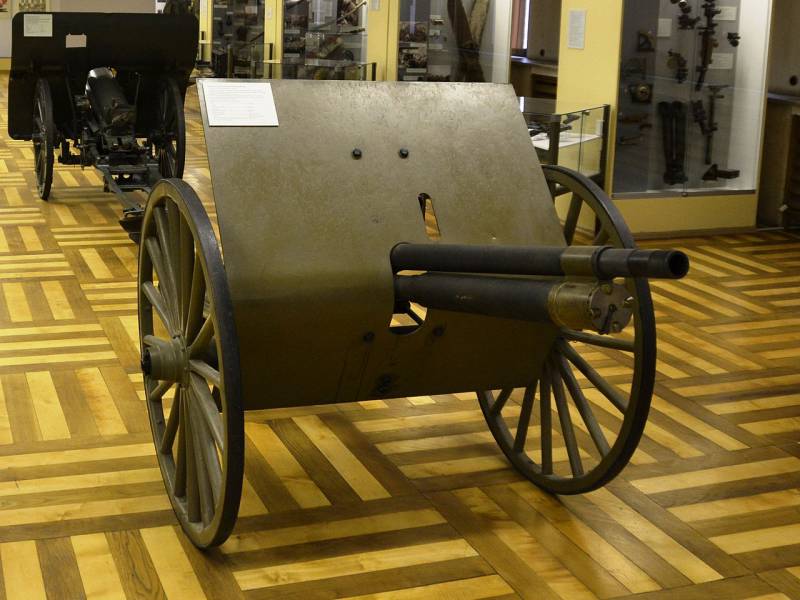
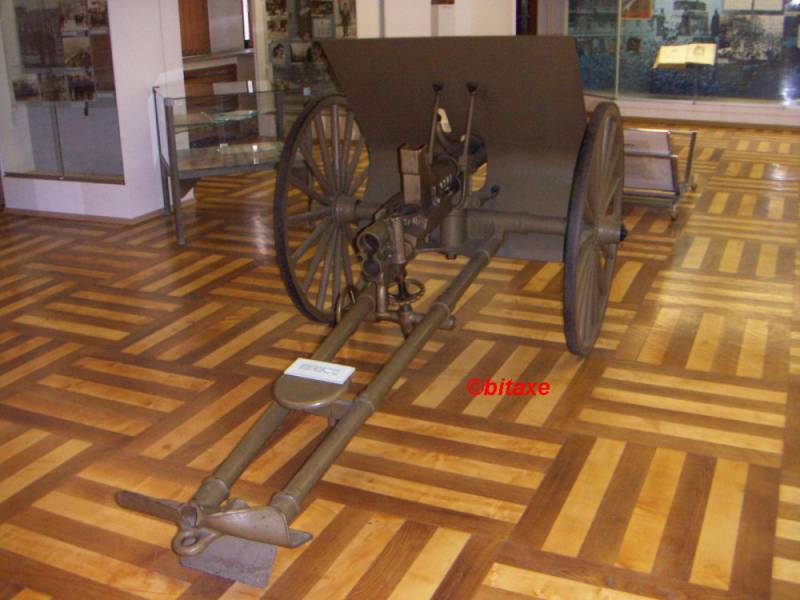
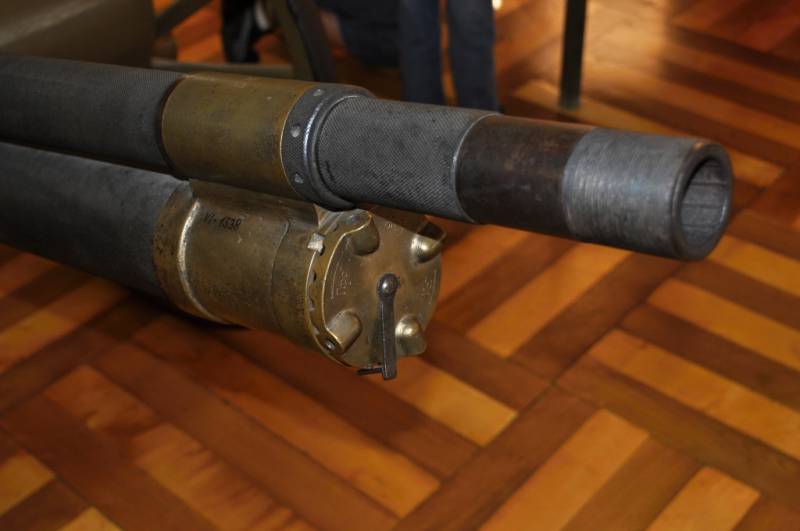
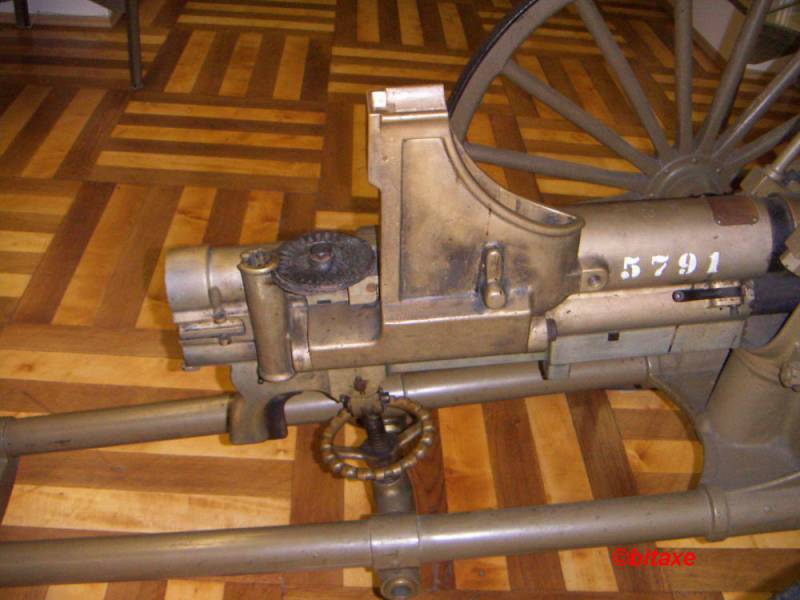

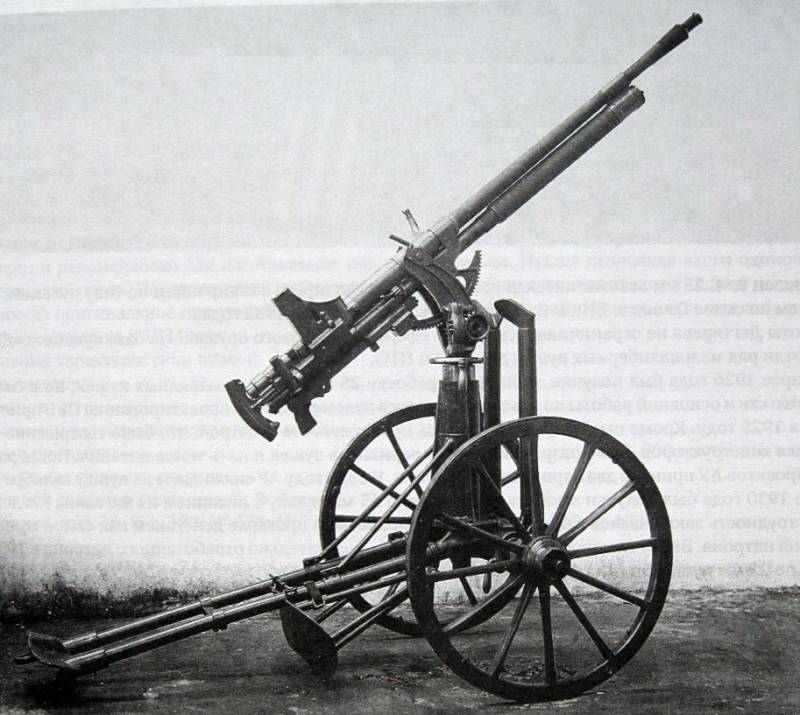
Information